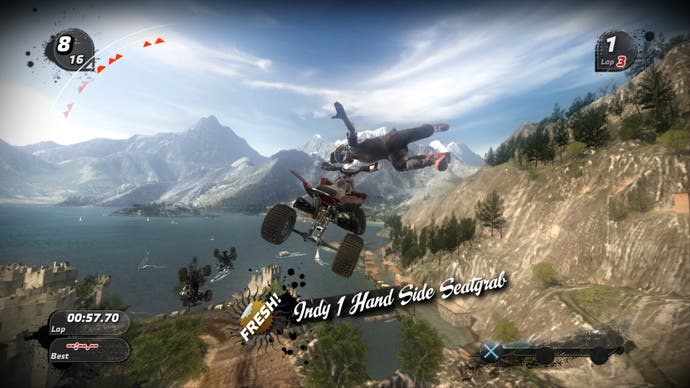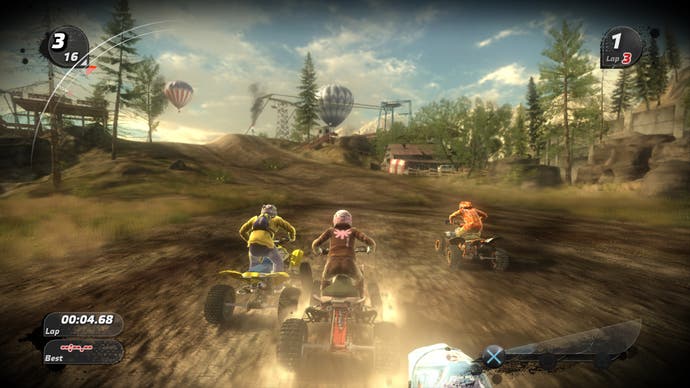Pure
And simple: buy it.
Apart from the obvious adrenaline rush of leaping headlong into stomach-churning drops, half the fun of Pure is learning how to stay in your saddle. At first, you'll eagerly trick at every opportunity, but such enthusiasm is generally rewarded with a swift cuff around the back of your head as you're launched, yet again, off the handlebars into certain death. Anticipating how much time you really have is all part of a fantastically well-judged learning curve.
As much as failure hurts, it's the best medicine, and you'll soon develop a wily appreciation of what represents a trick opportunity, and when to leave well alone. Like all the really great arcade racers of the past, part of Pure's inherent appeal is familiarity, and the way Black Rock builds that without it overstepping the mark with repetition is to be applauded.
Just as you start routinely winning Race events, at almost the exact same time, the game's Freestyle mode becomes an amazing amount of fun. This time you're not stressing about race position, but simply how your points tally is faring - and how much petrol you've got left in the tank. Unlike the other modes, you have a rapidly diminishing fuel supply, and the idea is that you've got to rack up as many stunts as possible before you run dry. Doing so is a tricky balancing act, because, as you'll have discovered, boosting is integral to enhancing your jump, but in Freestyle it drains your fuel quicker, leaving you with a choice over whether to go for a big combo multiplier, or try and stay in the race a little longer.
Dotted all around the track in Freestyle are four main pick-ups: fuel, boost, multiplier and one that effectively gives you the ability to instantly pull off a signature trick. At first, the AI riders will snaffle all of them from right under your nose, but as the event progresses, more pickup opportunities present themselves, giving you the chance to prolong the event and therefore clock up a winning scoreline. The key thing to accumulating a big score is keeping the combo multiplier topped-up, so you'll find yourself tricking off every little bump in the track - and usually taking far more risks into the bargain. But once you've got a better appreciation of what's feasible, it's possible to rack up some truly gargantuan scorelines, as the online leaderboards will prove. And although it's a little on the easy side to win offline, taking these matches online, in particular, should prove a real test for anyone, and a huge amount of fun.
The main criticism levelled at Pure is how quickly you can blitz through the majority of the game. Admittedly, the first five tiers are relatively easy, and within a couple of hours you'll have whipped through a good portion of the World Tour. That said, Pure's opening chunk does an excellent job of preparing players for the main meat of the game. By the time you reach, say, tier seven or eight, you're in for a real battle to accumulate enough points to progress. Often it's so tight that simply going back and winning races is the only way to gain access to the next tier, because without the requisite upgrade, you might otherwise struggle to match your opponents.

And while we're on the subject, it's worth noting that we haven't made a big deal about the customisation. Pre-release estimates reckoned that you could feasibly build up to 100,000 different types of quad-bike, but that's a bit meaningless in practical terms. Thanks to the game's excellent, clanking auto-build function, all the bits whizz across the screen into place, giving you the choice over whether to build a bike suited to freestyle or race disciplines.
With that feature, it's almost always best to just junk your last ride and let the computer build you a new one every time you get a significant performance upgrade. It's certainly quicker, at any rate. Less excitingly, there are also seven riders to choose from (one of whom is unlockable), but there's no real difference apart from perhaps a unique trick manoeuvre specific to that rider, so there's no real sense of attachment to any of them. Maybe Pure could have made more of them somehow. Answers on a postcard, please.
It's impossible to ignore Pure's excellent technical qualities. It is, quite simply, an extraordinarily pretty game, with some of the most lavishly detailed tracks ever conceived. With massive draw distances, a rock solid 30 frames-per-second, and some superbly designed courses, there's a real sense of artistry about the whole project. Nothing is lacking in any way, and the amount of polish applied to every element, from the bikes to the rider animation, gives an unlikely sense of conviction to a game which is, after all, utterly ludicrous on every level.

Best of all has to be the game's money shot: the freefall descent as you leap into the abyss. The bomb-drop whistling, the screen edge blurring, the slightly muted sound. You subconsciously hold your breath and feel like your heart's in your throat. It's a wonderfully realised effect. On that basis alone, Pure stands out from the crowd.
On reflection, though - in terms of modes, the number of tracks and gameplay variety - Pure does come up just a fraction too short to warrant dishing out a higher score. It feels like an incredible platform to build on, in the same way that Burnout set Criterion on a path to greatness. As much as the wonderful production values and refined trick-based gameplay deserve massive respect and critical acclaim, there's a sense that's there's more to come from Pure before it becomes the definite article. As a starting point for a successful brand, though, Black Rock has totally nailed it, and this represents a hugely promising effort. Stomach churning insanity doesn't get any better right now.

